

This page has been revised and more than 90 new images have been added | ||
| Sagrada Familia or the Temple Expiatori de la Sagrada Familia was begun in 1882 by public subscription. A year later Gaudí became director of the project, a post he would hold for more than 40 years until his death in 1926. After the completion of ParcGüell in 1911, he vowed that his architecture would not be devoted to secular aims. His commitment to this project is indicated as well by the fact that he lived in a studio on the site. "He was assisted by architects Berenguer, Rubió, Jujol, Canaleta and Ràfols, and in the last stage, by Sugrañes and Quintana; these last continued with the work after his death in 1926, until the towers of the Nativity facade were completed. After the Civil War, progress continued under Quintana, Puig i Boada and Bonet Garí, with the help of Bergós, Martinell and Dapena. In most recent decades, it has been Cardoner and Bonet Armengol assisted by architects Margarit, Buixadé and Gómez" (Carandell 87).
Work continued on the church based on Gaudí's general plan and studies. Unlike many churches, it survived during the Spanish Civil War, when many churches were burned; it was and is seen as a kind of symbol for the city of Barcelona. Although it is not the cathedral of Barcelona (which dates from the 13th century), it is sometimes called Barcelona's third cathedral. It is still unfinished today (note the cranes and scaffolding in various photographs below) and it is anybody's guess when it will be completed. It is a combination of Modernista elements and a unique version of the Gothic style--seen primarily in its height, use of rose windows and arches, triple portals, and architectural sculpture. | ||
| The church is in the shape of a Latin cross and has three facades, two corresponding to the arms of the cross, the Nativity facade and later the Passion facade. The third is situated at the start of the main nave. This, the Glory facade, is not completed. The Nativity Fašade was built before work was interrupted in 1935 and bears the most direct GaudÝ influence. | 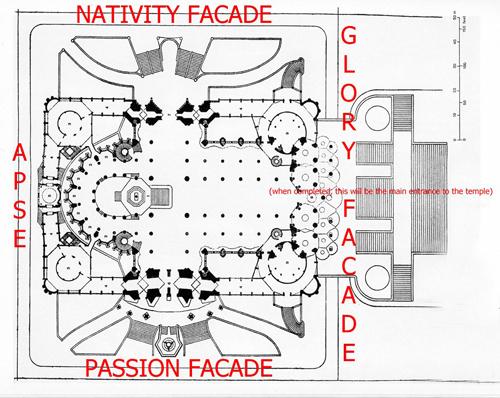 |
|
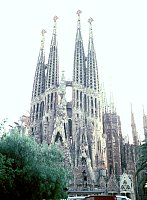
|
The facade of the NativityThe Facade of the Nativity, seen here, was completed first. The three portals of this facade are related to the Christian themes of faith, hope, and charity. The iconography supports the central dogmas of the Catholic church. Although biographical events are depicted, they are not necessarily in chronological order since the themes are more important than any time sequence. See below for specific themes and incidents.Eight spires of a projected twelve have been completed. (The four of the Nativity facade were finished before Gaudí's death.) These towers rise to more than 100 meters and symbolize the twelve apostles. The names and statues of the apostles, seated on pedestals, appear on the towers. | |
The pinnaclesThe pinnacles at the tops of the towers are decorated with colorful mosaics with various textures. The words "Excelsis" and "Hosanna" are embedded in some of the pinnacles. |
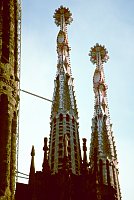 |
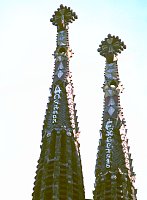
|
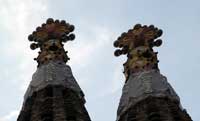
|
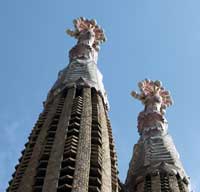
|
|
Left: Facade of the Nativity with its three portals; center: plant-inspired pinnacles; right: lower portion of the towers with "Sanctus" and the anagram for Christ's name (far right) | ||
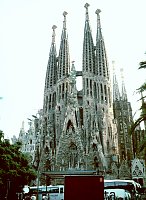
|

|
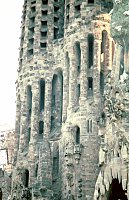
|
The Tree of LifeHigh up on the Nativity facade a spire with a cypress tree symbolizes the tree of life. A pelican at the foot of the tree symbolizes the Host and angels at the bottom hold chalices, a reminder of the Eucharist. At the top of the tree the letter T (or Tau) stands for God (as the first letter of God's name in the Greek alphabet). It is red with diagonal bars crossing it forming an X, representing Christ's name. A Dove at the top with outspread wings represents the Holy Spirit. Thus, the three persons of the Trinity are represented at the top of the tree of life. | ||

|
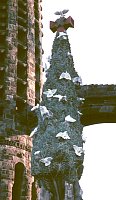
|

|
Index to additional pages on this magnificent church | ||
Facade of the Nativity: Central Portico--Door of Christian Love (or Charity)--2 pages (28 images) | ||
Facade of the Nativity: Left Portico--Door of Hope (10 images) | ||
Facade of the Nativity: Right Portico--Door of Faith (8 images) | ||
Facade of the Passion--2 pages (25 images) | ||
Views of the Apse (7 images) | ||
Views of the Interior (13 images) | ||
 Go to Gaudí Index.
Go to Gaudí Index.
 Click here to return to index of art historical sites.
Click here to return to index of art historical sites.
 Click here to return to index of artists and architects.
Click here to return to index of artists and architects.
 Click here to return to chronological index.
Click here to return to chronological index.
 Click here to see the home page of Bluffton College.
Click here to see the home page of Bluffton College.

